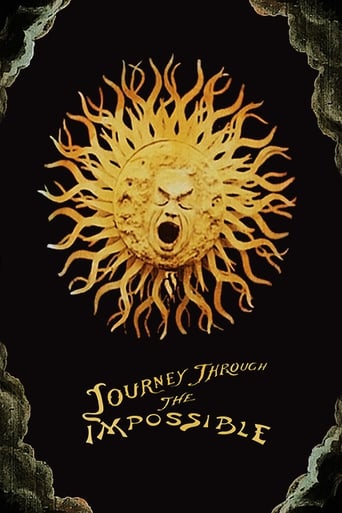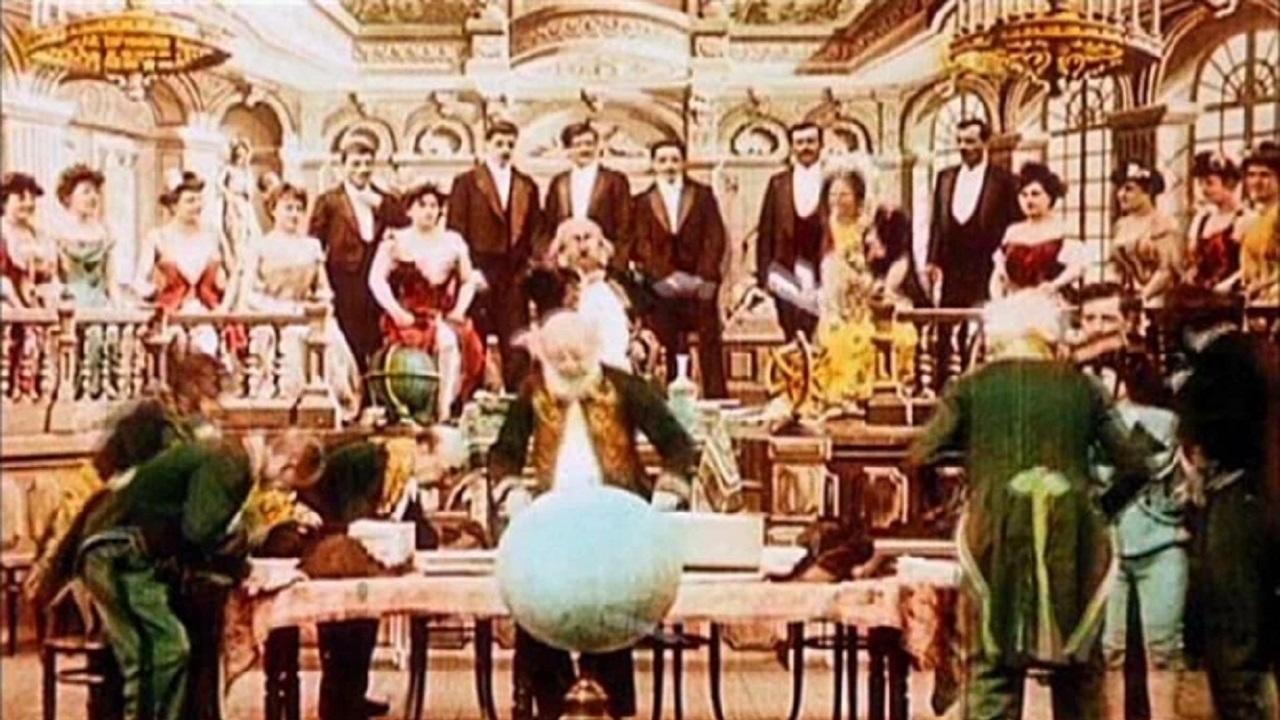Horst in Translation (filmreviews@web.de)
I recently saw the director's "Le voyage dans la lune" and while I didn't totally love it, it made a good viewing experience and I believe everybody who calls himself a cinephile should have seen it at least once. Now, two years later, the French cinema pioneer made another film considerably longer than most of his other work just like his moon travel story.Unfortunately, "Le voyage à travers l'impossible" did not leave me impressed. All in all, it felt like a recycled Trip to the Moon with an exchanged target location. There's nothing wrong with picking the sun as the explorers' destination this time. Sure it's impossible, but it's sci-fi and thus perfectly justified. But it's all been there and even done better (down to the sun's face) by the director himself. Honestly, I felt the first six minutes were downright boring. The actions and character movements looked exactly the same like in his previous project. The the action switches to the Alps, which is probably my favorite sequence. The scenes in the snow were interesting to watch, the hospital was nicely done and picking the mountains as a ramp to fly up to the sun was one of the few innovative ideas and executions in this short. The actual sun sequences were pretty forgettable again and so was the cheerful reception of the the explorers which was pretty much interchangeable with the one from two years earlier again.If you enjoyed "Le voyage dans la lune", I still think this one can be worth the watch if you don't mind this being mostly a weaker copy. But if you need to pick between the two, the Moon should always be your preferred destination.
Michael_Elliott
Impossible Voyage, The (1904) *** (out of 4) Melies attempt to pass his landmark A TRIP TO THE MOON doesn't quite come close to that but this here is still an entertaining little film. Running 20-minutes, this tells the story of a Geographic Society who build a special ship that will take them through the sky, to the sun and then under the sea. That's pretty much the only type of plot we get here as the master Frenchman really makes for an inter sting film that has more going on for it visually than anything story wise. I must admit that I found what little story we have here to be quite boring as none of the human characters are all that interesting (not too uncommon for 1904) but the places they visit really aren't that interesting either. The look of all the locations is what makes this film worth seeing as there's no doubt Melies put a lot of imagination into everything we're seeing. I really loved the hand-colored stuff as this too had imagination behind it and it wasn't just a scribbled mess. The underwater sequence is a good one but the highlight would have to be when the ship goes into the mouth of the sun.
JoeytheBrit
Having produced a blockbuster in 1903 in which a group of scientists journeyed to the moon, Melies tried to outdo himself the following year by having another group of manic scientists travel to the sun. He made this film longer and stencilled it in colour, and the outcome is quite astounding. To think that Melies was producing lengthy masterpieces like this while contemporary filmmakers were still experimenting with one-shot narratives goes to show how far ahead of his time Melies really was - which makes his downfall less than a decade later all the sadder. Melies fills the screen with colour with sets sometimes similar to the expressionist sets of the German masterpieces of the late teens and 20s, and fills it also with movement. Not one moment passes when there isn't something to look at. Although this film is not as widely known as Le Voyage dans la lune for my money it surpasses it in terms of exuberance and imagination.
Cineanalyst
As many others have noted, "The Impossible Voyage" essentially follows the same adventure structure as Méliès's earlier and most popular film, "Le Voyage dans la lune" (1902). They are, after all, both based on works by Jules Verne and Adolphe Dennery. "The Impossible Voyage", however, is more elaborate and nearly or about twice as long--especially with the additional couple minutes that were available as an extended ending to exhibitors at extra cost (this ending hasn't been included on the Image Entertainment and Kino releases, but has been recently rediscovered and may be released on the upcoming Flicker Alley release). According to historian John Frazer, it cost 37,500 francs ($7,500) to make. "The Impossible Voyage" is also more chaotic, or anarchic--lampooning science and the adventures of science fiction to far greater extent. Whereas in "Le Voyage dans la lune", there was a clear journey executed in a rather concise manner, "The Impossible Voyage", instead, follows a group from The Institute of Incoherent Geography, led by an engineer Mabouloff (which translates as "Scatterbrains" and is played by Méliès), and the journey is, indeed, incoherent at times and certainly not concisely executed. On their trip, they crash their automobile (and there seems to be no reason they were even using it) in the mountains and spend some time in a hospital. They also become frozen inside a refrigerator while on the Sun. Furthermore, a journey to the Sun is obviously absurd in itself, unlike that to the moon, which wasn't too far-fetched to the imagination even in 1902.The overall result of this is mixed. On the one hand, it's an ambitious and entertaining film for 1904; on the other hand, the increased emphasis on chaos and satire here over that in "Le Voyage dans la lune" dissolves some of the narrative structure and continuity, especially in how it elongates the picture. Additionally, I can only appreciate the theatrical shot-scene, tableau style of Méliès's narratives in limited amounts. The fallacy of attempting to make cinema an extension of theatre, which was one of Méliès's stated goals, was fully exposed as a travesty with the early feature-length films (for example, "Queen Elizabeth" (Les Amours de la reine Élisabeth) (1912)) that were theatrical dramas rather than fantasies with spectacular theatrical effects. It's also not often acknowledged that filmmaker contemporaries of Méliès were already introducing and experimenting with the cinematic techniques of scene dissection, continuity editing and different camera positions. George Albert Smith, whom Méliès had even had correspondence with, was probably at the forefront of early pioneers in this respect, but also by the mid to late 1900s, the Vitagraph and Pathé companies were already employing crosscutting. Later, Méliès was also a contemporary of D.W. Griffith. Thus, I can't give Méliès a total pass because of his era. Yet, for its time and for what it is, "The Impossible Voyage" remains a somewhat entertaining and amusing film to this day, although I rank it lower than "Le Voyage dans la lune" and even some of his other fantasies, such as "Bluebeard" (1901) and "Kingdom of the Fairies" (1903).On a further note, at this time--in the era of fairground exhibition of cinema--extra-filmic lecturers, or narrators, would aid audiences in following these new complex narrative films, or provide supplemental information to them. Méliès wrote narration to his story films, such as "The Impossible Voyage", for this purpose. Méliès also offered most of his films in hand-colored versions, for which exhibitors would have to pay an extra price (to give some credit, a team of women headed by a Mrs. Thullier hand colored most of them). Fortunately, and unlike some of his other films, "The Impossible Voyage" is generally available today in a hand-colored version with narration. It's helpful, and it works against some of the other limits of the film. Of the narration, however, it's also another example of the primitiveness of Méliès's films; it may be seen as an admission of their lack of cinematic storytelling and self-contained narration (or, as historian Noël Burch would say, it's "non-closed").


 AD
AD




